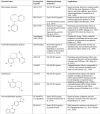The Signaling and Pharmacology of the Dopamine D1 Receptor
- PMID: 35110997
- PMCID: PMC8801442
- DOI: 10.3389/fncel.2021.806618
The Signaling and Pharmacology of the Dopamine D1 Receptor
Abstract
The dopamine D1 receptor (D1R) is a Gαs/olf-coupled GPCR that is expressed in the midbrain and forebrain, regulating motor behavior, reward, motivational states, and cognitive processes. Although the D1R was initially identified as a promising drug target almost 40 years ago, the development of clinically useful ligands has until recently been hampered by a lack of suitable candidate molecules. The emergence of new non-catechol D1R agonists, biased agonists, and allosteric modulators has renewed clinical interest in drugs targeting this receptor, specifically for the treatment of motor impairment in Parkinson's Disease, and cognitive impairment in neuropsychiatric disorders. To develop better therapeutics, advances in ligand chemistry must be matched by an expanded understanding of D1R signaling across cell populations in the brain, and in disease states. Depending on the brain region, the D1R couples primarily to either Gαs or Gαolf through which it activates a cAMP/PKA-dependent signaling cascade that can regulate neuronal excitability, stimulate gene expression, and facilitate synaptic plasticity. However, like many GPCRs, the D1R can signal through multiple downstream pathways, and specific signaling signatures may differ between cell types or be altered in disease. To guide development of improved D1R ligands, it is important to understand how signaling unfolds in specific target cells, and how this signaling affects circuit function and behavior. In this review, we provide a summary of D1R-directed signaling in various neuronal populations and describe how specific pathways have been linked to physiological and behavioral outcomes. In addition, we address the current state of D1R drug development, including the pharmacology of newly developed non-catecholamine ligands, and discuss the potential utility of D1R-agonists in Parkinson's Disease and cognitive impairment.
Keywords: G protein-coupled receptors; Parkinson's Disease; biased agonism; cognitive impairment (CI); dopamine D1 receptor; drug development; intracellular signaling.
Copyright © 2022 Jones-Tabah, Mohammad, Paulus, Clarke and Hébert.
Conflict of interest statement
The authors declare that the research was conducted in the absence of any commercial or financial relationships that could be construed as a potential conflict of interest.
Figures



References
-
- Alcacer C., Charbonnier-Beaupel F., Corvol J. C., Girault J. A., Hervé D. (2014). Mitogen- and stress-activated protein kinase 1 is required for specific signaling responses in dopamine-denervated mouse striatum, but is not necessary for L-DOPA-induced dyskinesia. Neurosci. Lett. 583, 76–80. 10.1016/j.neulet.2014.09.018 - DOI - PubMed
-
- Alcacer C., Santini E., Valjent E., Gaven F., Girault J.-A., Hervé D. (2012). Gαolf mutation allows parsing the role of cAMP-dependent and extracellular signal-regulated kinase-dependent signaling in l-3,4-dihydroxyphenylalanine-induced dyskinesia. J. Neurosci. 32, 5900–5910. 10.1523/JNEUROSCI.0837-12.2012 - DOI - PMC - PubMed
Publication types
LinkOut - more resources
Full Text Sources
Other Literature Sources

